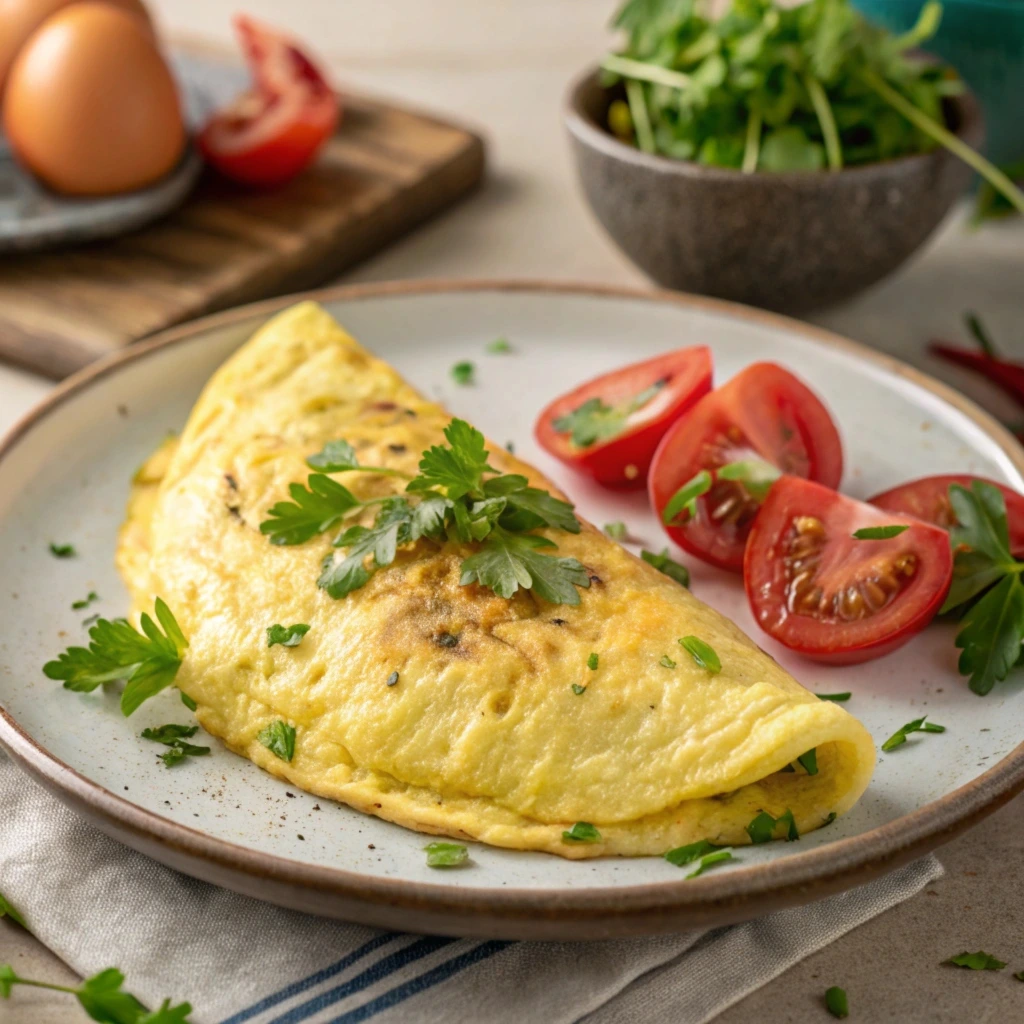Introduction
Omelets are a staple in kitchens worldwide, loved for their versatility, simplicity, and quick preparation time. But making the perfect omelet—light, fluffy, and with the ideal texture—requires technique, patience, and the right ingredients. You might have encountered the occasional omelet disaster: either overcooked, too dry, or stuck to the pan. If that’s you, don’t worry—you’re not alone!
Personal Experience:
I used to struggle with making the perfect omelet. I’d either get a gooey mess or one that was way too hard. After experimenting for years, I discovered a few key techniques and ingredients that have helped me craft an omelet worthy of a professional kitchen. In this guide, I’ll walk you through the process, from choosing the right ingredients to the art of cooking and folding the omelet, so you can enjoy the perfect omelet every time.
Why Omelets Are Great for Any Meal:
One of the reasons omelets are such a great breakfast (or any-time meal) is their versatility. You can make them sweet or savory, light or hearty, depending on your mood and what ingredients you have on hand. Plus, omelets are quick and easy to make, so they’re perfect when you’re in a rush.
Let’s dive into the steps and techniques that will elevate your omelet-making skills to new heights!

Why Omelets Are the Perfect Breakfast Choice
Omelets are more than just a breakfast food; they’re a canvas for creativity and nutrition, all in one. Here’s why omelets are the perfect choice for your morning meal.
The Versatility of Omelets
Discover creative ways to enjoy omelets around the world with this guide to global omelet variations. From French-style classics to hearty Spanish tortillas, explore how this dish adapts to every cuisine and palate!
Omelets can be tailored to suit your taste buds, dietary needs, and even your mood. From traditional fillings like cheese and ham to more adventurous combinations like smoked salmon or spicy peppers, the possibilities are endless. Whether you’re in the mood for something light, savory, or indulgent, there’s an omelet variation for everyone.
- Popular filling ideas:
- Classic: Cheese, ham, and mushrooms.
- Vegan: Spinach, avocado, and tomatoes.
- High-protein: Eggs, cheese, turkey bacon, and spinach.
Quick and Easy to Make
When you’re short on time in the morning, an omelet is the ideal solution. From crack to plate, you can have a perfectly cooked omelet in less than 10 minutes. That’s faster than many other breakfast options, such as pancakes or waffles, and far less complicated than cooking a full English breakfast. With just a handful of ingredients, you can enjoy a satisfying meal in a flash.
- Time-saving benefits:
Omelets require minimal prep time. With just eggs, seasonings, and fillings, you can quickly whip up something delicious and filling without spending too much time in the kitchen.
Nutritious and Customizable
The beauty of omelets is their ability to be a protein-packed powerhouse, full of vitamins and nutrients, all depending on the ingredients you add. You can easily make your omelet more nutritious by including vegetables, lean meats, and even whole grains like quinoa for added texture and fiber.
- Health benefits:
- Eggs are rich in protein, essential vitamins, and minerals like B12 and Vitamin D.
- Adding vegetables like spinach or mushrooms boosts the omelet’s nutritional profile with vitamins, antioxidants, and fiber.

Essential Ingredients for the Perfect Omelet
Now that we’ve established why omelets are great, let’s dive into the essential ingredients that make up the foundation of a perfect omelet.
Eggs: The Foundation of a Perfect Omelet
Learn more about choosing the best eggs for cooking from this guide on egg quality and freshness. Discover tips on selecting, storing, and using eggs to elevate your omelet-making skills
The key to making a fluffy omelet lies in the eggs themselves. Eggs are a delicate ingredient, and the type you use can influence the texture and flavor of your omelet. While it’s tempting to grab any eggs from your fridge, consider the following tips:
- What to look for in eggs:
Fresh eggs are a must. Look for eggs that are free-range or organic, as these often have better flavor and a richer yolk color. Fresh eggs also tend to hold together better, which is important when flipping your omelet. - The egg-to-fillings ratio:
A good rule of thumb is to use 2-3 eggs per omelet. This provides enough egg to form the structure without overwhelming the fillings.
Fats: Choosing the Right Oils and Butters
The type of fat you use plays a significant role in both flavor and texture. The right fat ensures your omelet cooks evenly and smoothly, while also enhancing the overall taste.
- Butter: Adds richness and a velvety texture to your omelet. If you prefer a luxurious omelet, butter is the go-to choice.
- Olive oil: A lighter option for those watching their calories or looking for a healthier alternative. Olive oil adds a subtle, savory flavor.
- Ghee: Clarified butter, or ghee, is another excellent choice, particularly for those avoiding dairy proteins. It adds a nutty flavor and has a high smoking point, making it ideal for cooking at medium heat.
Cheese and Fillings
The possibilities for fillings are endless. You can go as simple or as complex as you like, but the key is not to overload the omelet, as this can lead to a messy outcome.
- Popular cheeses:
- Cheddar: Sharp and melts beautifully.
- Goat cheese: Tangy and creamy.
- Mozzarella: Mild and gooey.
- Fillings:
- Vegetables: Spinach, mushrooms, peppers, onions.
- Proteins: Ham, turkey, bacon, sausage.
- Herbs: Fresh herbs like parsley, chives, and basil can add a burst of flavor without overpowering the omelet.
Seasoning: The Final Touch
Seasoning may seem like an afterthought, but it’s crucial for making a flavorful omelet. Salt and pepper are the essentials, but don’t be afraid to get creative with spices and herbs.
- Spices:
A pinch of paprika, garlic powder, or cayenne can add a lovely depth of flavor without making the omelet too spicy. - Fresh herbs:
Chives, parsley, and dill are excellent additions that brighten up the omelet with a fresh, herbaceous kick.

Step-by-Step Guide to Making the Perfect Omelet
Once you have all your ingredients prepared, it’s time to start cooking. Here’s the step-by-step guide to creating an omelet that will impress everyone.
Step 1: Preparing Your Pan
A good omelet starts with a great pan. Here’s how to set yourself up for success:
- Choosing the right pan:
A 10-inch non-stick skillet is ideal. It allows for even heat distribution and prevents sticking, making it easier to cook and flip your omelet. - Heating the pan:
Preheat the skillet over medium-low heat. Allow the pan to warm up for a few minutes before adding any fat. If the pan is too hot, the eggs will cook too quickly, causing an uneven texture.
Step 2: Beating the Eggs for the Right Texture
Beating the eggs properly is essential to achieving that perfect fluffiness.
- Whisking technique:
Use a whisk or a fork to beat the eggs until the yolks and whites are fully combined. You want to introduce air into the mixture to create a light, fluffy texture. Aim for 30 seconds of vigorous whisking. - Add salt and pepper:
Season the eggs before cooking to ensure that the flavors are evenly distributed.
Step 3: Cooking the Omelet at the Right Temperature
Now that your eggs are ready, it’s time to cook them.
- The right temperature:
Pour the beaten eggs into the preheated pan and cook on medium-low heat. The eggs should start setting at the edges but remain soft in the middle. Tilt the pan slightly to allow the uncooked egg mixture to flow to the edges. - Avoid overcooking:
You want the eggs to be set but still slightly runny in the middle for a soft, tender texture.
Step 4: Adding Fillings Without Overloading
Once the eggs are mostly set but still slightly runny on top, it’s time to add the fillings.
- Evenly distribute fillings:
Gently add your cheese, veggies, or proteins to one half of the omelet. Avoid overcrowding, as too many fillings can weigh it down, making it difficult to fold. - Folding the omelet:
Use a spatula to carefully fold the omelet in half. Allow it to cook for a few seconds longer, then slide it onto a plate.
Making a perfect omelet isn’t just about following the steps; it’s also about knowing a few key tricks that ensure success every time.
Cooking Temperature and Timing
The right temperature is essential for a tender omelet. Keep the heat low to prevent overcooking.
- Ideal temperature:
Medium-low heat is the sweet spot. This allows the eggs to cook evenly without becoming too dry or rubbery.
Avoiding Overcooking
Overcooking is the number one culprit for a dry omelet. Learn how to tell when your omelet is done perfectly.
- Watch the edges:
The edges should be golden and slightly crisp, but the center should still be soft and slightly runny.
Mastering the Fold
The fold is where many people struggle, but with the right technique, it can be effortless.
- Perfect fold:
Once the omelet is set, use your spatula to gently lift one side of the omelet and fold it over the fillings. If done right, the omelet will have a smooth, neat appearance.
Creative Omelet Variations to Try
Omelets aren’t just for breakfast; they’re a versatile meal that can be customized to suit any palate. Here are a few creative variations to try.
Vegetarian Omelets
From sautéed vegetables to creamy cheeses, vegetarian omelets are full of flavor and can be a hearty meal.
- Veggie omelet ideas:
- Spinach, mushroom, and goat cheese omelet.
- Tomato, zucchini, and mozzarella omelet.
Meat Lovers’ Omelets
For those who love a meaty, protein-packed breakfast, a meat-lover’s omelet is the perfect choice.
- Meat options:
- Bacon, ham, and cheddar cheese.
- Sausage, spinach, and pepper jack cheese.
Gourmet Omelets
Elevate your omelet to gourmet status with luxurious ingredients and unique flavor combinations.
- Gourmet ideas:
- Smoked salmon, cream cheese, and capers.
- Truffle oil, mushrooms, and parmesan.
International Omelets
Try omelet variations from around the world, from French omelets to the Spanish tortilla.
- International variations:
- French omelet: Simple, soft, and filled with just a little butter and fresh herbs.
- Spanish tortilla: Thick omelet with potatoes and onions.

Conclusion
Making the perfect omelet is an art that anyone can master. With the right ingredients, the proper technique, and a little practice, you can create an omelet that’s both fluffy and full of flavor every time. Whether you stick to the classic version or get creative with fillings, omelets are a meal that never gets old.
Call to Action:
Now that you have all the tips and techniques, it’s time to get cooking! Try out the perfect omelet recipe and experiment with your favorite fillings. Don’t forget to share your creations in the comments below or tag me on social media for a chance to be featured.
FAQ Section
Q1: How do I make a vegan omelet?
You can easily make a vegan omelet using plant-based alternatives such as chickpea flour or silken tofu. Add your favorite vegetables and vegan cheese for a delicious and dairy-free omelet.
Q2: Can I make an omelet ahead of time?
While omelets are best served fresh, you can prepare the filling ingredients in advance and store them in the fridge. When ready to cook, just add the fillings to your beaten eggs.
Q3: What’s the best way to store leftover omelets?
Store leftover omelets in an airtight container in the refrigerator. They’ll stay fresh for up to 2 days. Reheat in a skillet over low heat or in the microwave for a quick breakfast or snack.
